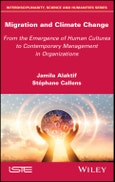Table of Contents
Introduction ix
Part 1. The First Cultures in a Context of High Climate Instability 1
Chapter 1. Migration and Creativity: What Roles do They Play During Climate Change? 3
1.1. A necessary evil 3
1.1.1. The methodological challenge of a global history 4
1.1.2. Denial or a mandate from heaven 5
1.2. Cultures and climatic gradient 6
1.3. The conquest of ubiquity 12
1.4. Migration: capacity or necessity? 15
1.4.1. H. ergaster’s African exits 16
1.4.2. The African exits of anatomically modern humans 16
1.5. The oboes of the Swabian Jura 19
1.5.1. Climate change and the birth of the arts19
1.5.2. European cultures of the Upper Paleolithic and Heinrich events 22
1.6. Discussion 25
Chapter 2. Living with the Extreme 27
2.1. The example of super-flooding 27
2.2. In search of a new interpretative framework 29
2.3. Extreme measurements 30
2.3.1. Laughter: characterizing risk in climate change? 31
2.3.2. Ecstasy 32
2.3.3. Sacrifice 33
2.3.4. Communication 34
2.4. The first GLOF cultures 35
2.4.1. The “bathymetry” of myths and tales 35
2.4.2. Some examples of cultures associated with GLOFs 36
2.4.3. The severity of the floods and their cultural translation 39
2.4.4. The objectification of ice sheet GLOFs 40
2.5. The first cultural groups of anatomically modern humans and climate change 42
2.6. The problem of Apollo’s birth 45
2.7. The constitution of dragons, gods and humans in the myths of the flooding of hydraulic civilizations 47
2.8. Discussion 48
Chapter 3. The Great Historical Transitions of Climate Cultures 51
3.1. Historical human cultures, between fiction and knowledge of natural risks 51
3.2. Water, a historical problem, from Mesoamerica to Africa 54
3.2.1. Human cultures facing floods 55
3.2.2. “Dragon” myths 57
3.3. Human diversity and taiga shamanism 60
3.3.1. Contemporary shamanism, a look at Eros and Askêsis 61
3.3.2. Paleolithic cultures according to climate change 64
3.4. Spiritual corporalities of body paintings 69
3.5. Myths linked to the problem of water: first texts and first empires 72
3.5.1. The Superwise 74
3.5.2. Court shamanism 76
3.5.3. Rome and China 78
3.6. Discussion: the politicization of corporalities 80
Part 2. Contemporary Cultures and Climate Change 83
Chapter 4. Norms and Diversity in Climate Change 85
4.1. Climate change and normativity 85
4.1.1. Normativity and resilience 85
4.1.2. Norms and the environment 86
4.1.3. History of climate change policy 88
4.1.4. Mitigation and adaptation 90
4.2. Normativity and diversity 91
4.2.1. Diversity: a table of theoretical insights 91
4.2.2. Contingency 95
4.2.3. Otherness and truth 96
4.2.4. Governance and separation of powers. 98
4.2.5. Operational benefits 99
4.2.6. Discussion: what diversities for the climate? 101
4.3. The hard and soft law discussion 102
4.4. Normativity and climate migration 105
4.4.1. Climate motivations in migration 106
4.4.2. Competition of norms in soft and hard law 108
Chapter 5. Organization, Climate and Sustainable Development 111
5.1. Organizations and time horizons: Beck’s theory 111
5.1.1. Organization and globalization 111
5.1.2. Beck’s theory 112
5.2. Corporate social responsibility (CSR) 116
5.2.1. Soft law as a standardization of voluntary commitments 116
5.2.2. Voluntary engagement standards and “cosmopolitan climate risk communities” 119
5.2.3. Diversity and governance in climate change 121
5.3. Organization and decentralization in the energy transition: the example of Senegal 124
5.3.1. Africa, the green continent in the quest for sustainability 124
5.3.2. Senegal’s Renewable Energy Access Program 128
5.3.3. A need to articulate public decentralization and renewable energy 132
5.3.4. Quality, pricing and decentralization: an international political economy of energy access 133
Chapter 6. Climate and Religion in Protectionism 137
6.1. Climate change and protectionism 137
6.2. Mercantilism and religion 141
6.2.1. Papal bulls, an example of religious regionalism 143
6.2.2. Economic nationalism 144
6.2.3. Customs revenue 145
6.3. Parliamentary protectionism and religion: a comparison of France and the United States 147
6.3.1. France 149
6.3.2. The United States 151
6.4. Interfaith dialogue and fundamentalism 154
6.4.1. Traditionalism, fundamentalism and trade policy 155
6.4.2. The bridge or the wall 156
6.4.3. Discussion 158
Conclusion 159
Glossary 185
References 191
Index 201








